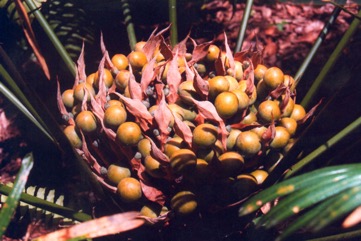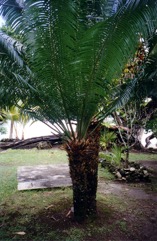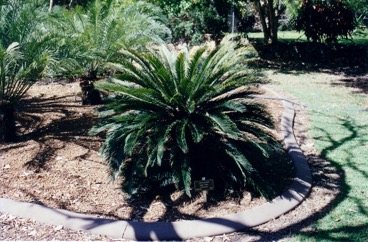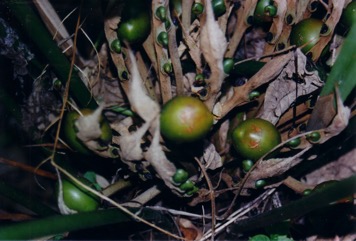Nut Palm, Fern palm, False sago palm, Zamia palm

A tropical plant. It prefers light to medium well-drained soil. It needs a protected sunny position. They are drought tender and frost hardy to light frosts. They need a temperature above 13°C. Trunks can resist fire and will regrow new leaves. It cannot tolerate bad drainage or deep shade. In the Cairns Botanical Gardens. It suits hardiness zones 10-12.
Also known as:
Baveu, Mayi badil
Synonyms
- Sometimes confused with Cycas armstrongii
- Cycas kennedyana F. Muell.
Edible Portion
- Kernels, Leaves, Nuts
Where does Nut Palm grow?
Found in: Australia, Pacific, Papua New Guinea, PNG
Notes: There are about 20-40 Cycas species.
Growing Nut Palm, Fern palm, False sago palm, Zamia palm
Cultivation: Plants are grown from seed. Seed are slow to germinate. They can be transplanted. If large plants are transplanted they take a year or more to re-establish.
Edible Uses: CAUTION: The seeds are very poisonous. They cause liver damage. They have been processed and eaten by aboriginal people. The trunks have also been used to extract starch which was eaten.
Production: Plants grow slowly.
Nutrition Info
per 100g edible portion| Edible Part | Energy (kcal) | Protein (g) | Iron (mg) | Vitamin A (ug) | Vitamin c (mg) | Zinc (mg) | % Water |
|---|---|---|---|---|---|---|---|
| Nut processed | 122 | 5.1 | - | - | - | - | 67.7 |
Nut Palm, Fern palm, False sago palm, Zamia palm Photos




References
Anon., 2003, Native Plants for the Fitzroy basin. Society for Growing Australian Plants Inc. (Rockhampton Branch)
Beck, W., 1992, Aboriginal Preparation of Cycas Seeds in Australia. Economic Botany, Vol. 46, No. 2, pp. 133-147
Blomberry, A.M., 1979, Australian Native Plants. Angus and Robertson p 110
Bodkin, F., 1991, Encyclopedia Botanica. Cornstalk publishing, p 311
Brickell, C. (Ed.), 1999, The Royal Horticultural Society A-Z Encyclopedia of Garden Plants. Convent Garden Books. p 326
Cooper, W. and Cooper, W., 2004, Fruits of the Australian Tropical Rainforest. Nokomis Editions, Victoria, Australia. p 1
Cribb, A.B. & J.W., 1976, Wild Food in Australia, Fontana. p 83, 105
Cronin, L., 1989, The Concise Australian Flora. Reed. p 257
Cundall, P., (ed.), 2004, Gardening Australia: flora: the gardener's bible. ABC Books. p 449
Djunbunji Newsletter Edition 2 2011. p 5
Elliot, W.R., & Jones, D.L., 1984, Encyclopedia of Australian Plants suitable for cultivation. Vol 3. Lothian. p 149
Hibbert, M., 2002, The Aussie Plant Finder 2002, Florilegium. p 79 (Also as Cycas kennedyana)
Hinton, B & B., 1982, A Wilderness in Bloom. Wildflowers of tropical Australia. p 20
Jackes, B.R., 2001, Plants of the Tropics. Rainforest to Heath. An Identification Guide. James Cook University. p 49
Jones D, L, 1986, Ornamental Rainforest Plants in Australia, Reed Books, p 331
Jones, D.L., 2000, Cycads of the world. Reed New Holland. p 145
Lazarides, M. & Hince, B., 1993, Handbook of Economic Plants of Australia, CSIRO. p 71
Leiper, G & Houser, J., Mutooroo. Plant Use by Australian Aboriginal People. Assembly press, Queensland. (As Cycas kennedyana)
Lord, E.E., & Willis, J.H., 1999, Shrubs and Trees for Australian gardens. Lothian. p 95
Low, T., 1991, Wild Food Plants of Australia. Australian Nature FieldGuide, Angus & Robertson. p 139
Low, T., 1992, Bush Tucker. Australia’s Wild Food Harvest. Angus & Robertson. p 82
Menninger, E.A., 1977, Edible Nuts of the World. Horticultural Books. Florida p 162
Molyneux, B & Forrester, S., 1997, The Austraflora A-Z of Australian Plants. Reed. p 71
Pearson, S. & A., 1992, Rainforest Plants of Eastern Australia. Kangaroo Press p 76
Prodr. 348. 1810
Ratcliffe D & P., 1987, Australian Native Plants for Indoors. Little Hills press. p 76
Townsend, K., 1994, Across the Top. Gardening with Australian Plants in the tropics. Society for Growing Australian Plants, Townsville Branch Inc. p 153 (Also as Cycas kennedyana)
Wickens, G.E., 1995, Edible Nuts. FAO Non-wood forest products. FAO, Rome. p173